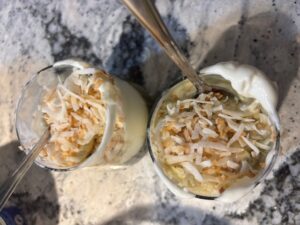Last week I bottled up our first ferment to make four flavours of kombucha: Pineapple Mango, Strawberry Cream Soda, Blueberry and Kiwi. This week it was time to test our second ferments.
I moved our production to the basement. I started out burping the kombucha. As you will see in the video that follows my first time opening the flip top bottle I was quite nervous. Thankfully the first flip open on the Pineapple Mango was not very explosive. There was a little carbonation. It did have a nice flavour profile. Next I opened the Strawberry Cream Soda. This one had a lot of pulp. In our taste test my daughter and I thought this one was quite flavourful. Having opened two flavours I went into opening the third, Blueberry with a little more confidence. It was explosive! The blueberry was so pressured that it sprayed the roof, wall 10 feet behind and even hit my cream coloured couch in the adjoining living room. This was a little upsetting and I spent most of the evening cleaning. I will have to replace the drop ceiling tiles. Thankfully I was able to get it out of the couch cushions. Into the fridge went our second fermentation to prevent over carbonation.

We now open our kombucha outdoors. The blueberry was a bubbly disaster. It tasted horrible, it was overly sweet with a boozy aftertaste. Finally we ended off our flavour tests with the kiwi. It came out on top for flavour despite not being carbonated. It was tangy, sour and sweet and my daughter’s favourite.
I think I need to learn yet about carbonation. I listened to a podcast this week that while it was from a commercial brewer it left me with a few questions. In this podcast, Living Full Kombucha – Teacher Turned Alchemist/ Episode 17- All Things Flavoring, she speaks of force carbonating her kombucha. Can I do that? Is that what they are doing with kombucha I purchase at the grocery store? I love when a kombucha is carbonated and yet my explosive tests this week leave me questioning does increased carbonation also equate to a boozy taste? My blueberry had the most carbonation, but it was also the worst. The kiwi had the least carbonation, but tasted the best.
It was interesting to hear that as a commercial brewer she is only working on mastering three flagship flavours. Here I was trying out four flavours! Actually, I am sure she landed on these three flavours after much trial even though she does not mention this. Part of mastering these three flavours is keeping consistent flavour, and a low alcohol content while increasing batch size. A low pH starter that was acidic combats bacteria and drives down alcohol content she shared. I thought the podcast was very interesting, she was good at storytelling and I may return to her story later. I enjoy listening to podcasts for their flexibility. I can listen while driving, walking or doing chores around the house. As a way of learning a skill it is easy to fit learning into daily life. I also enjoy auditory experiences in my downtime as sometimes I come home from a day of screens and feel like my eyes could use a rest. At the same time the podcast was a little confusing for where I am in my journey. A podcast has limited interactivity. In a way it is harder to practice alongside the content or visualize what the speaker is saying. If I was really learning from this experience or another podcast I would need to pause and replay frequently, which disrupts flow.
After the question of carbonation was raised I mined Youtube for videos on carbonation. YouTube makes it easy to see process in action. At first I was excited to find Bite Scized Education had a video on the Science Behind Kombucha Carbonation and I could connect with Molly’s journey. The hardest part she found initially when she was learning how to make kombucha was deciding if she wanted it fizzy and then how fizzy. “Making kombucha that is not fizzy is so much easier.” This video models scientific thinking and encourages curiosity, observation and inquiry by setting up a testable question. She asks “can we engineer a way to measure the pressure that builds inside a bottle.”She then builds a few prototypes to measure the pressure including using a gauge from a basketball, a recycled bottle and household glue. This demonstrates that learning is not always about answers, but the process of exploration. While this was a fun video to watch she concludes that maybe it is up to us the viewers to figure out. The conclusion is open ended leaving viewers to think critically and encourages active engagement. However, this lack of closure still leaves me confused without clear answers. It still feels ambiguous.
In this next video, the creator talks about carbonation being something that every brewer struggles with at some point. To address it he also uses a scientific process to test various variables in a lime juice kombucha. Controls include temperature (stored in a chest set to 78 degrees) and 9 grams of sugar in each bottle. The changing variables include nucleation sites (lime pulp, ginger, strawberry), pH (removing lime juice replacing with more simple sugar and zest) and time. The takeaways were to reduce the amount of pulp (nucleation sites) and that ginger always overwhelms. The most explosive/pops were the ones with increased nucleation sites yet after the explosive impressive show (the strawberry) what remained in the bottle was flat. The creator’s advice was to increase the amount of time as the second bottle with 7 days of fermentation compared to 3 in each of the others produced an effervescent, carbonated, delightful tingle with the best flavour profile. This video is helpful to see various variables manipulated. Viewers might apply these findings in their own problem-solving process especially with citrus based kombuchas. I appreciate his conclusions even if I might not be able at this time to control variables like temperature or sugar levels. I wonder if he is letting it ferment for the full 7 days without burping. It seemed like the 7 day open was the first open. I reflect on Madison’s instructions to leave the second ferment for 7 days before returning to the fridge. Further, she added in juice rather than fruit. Perhaps there is something in having less nucleation sites!
This week I am going to scale back my flavours and test the lime kombucha that this creator makes. I am going to be patient and wait the entire 7 days before opening my second ferment. I am also going to test the kiwi kombucha again/juicing the kiwi this time and waiting 7 days.

As a fun addition to this weeks learning, I thought I might make a matcha kombucha float with the first ferment this week and I thought it was delicious.
Inspiration was a matcha float . Instead of sparkling water I added kombucha because Food52 has an article on why kombucha floats are the greatest drink of the year (even if it was 2019).
Your kombucha journey is so fun and detailed! I love how you experimented with flavours, learned from both successes and explosive mishaps, and explored carbonation scientifically. The way you combined podcasts, YouTube, and hands-on testing shows great curiosity and persistence. That matcha kombucha float sounds amazing , can’t wait to hear how your 7-day ferment experiments turn out!
Hi Rhonda,
Wow, what a fun and wild week of kombucha adventures haha! I could totally picture the moment with the blueberry explosion, the way that you described it spraying the ceiling and even reaching your couch made me laugh out loud (I know it probably wasn’t funny in the moment, but I hope you are able to laugh about it now haha). It sounds like you handled it with good humor and a lot of patience.
I love how you are learning through podcasts, YouTube videos, as well as hands-on learning experiences. It is cool how you noticed the fizziest kombucha tasted the worst, while the kiwi and less bubbly one came out best. It sounds like you are really figuring out your own brewing style!
I can’t wait to hear about how your lime and kiwi experiment turns out. That matcha kombucha float sounds delicious! Here is to hoping for no more bottle explosions next time haha!